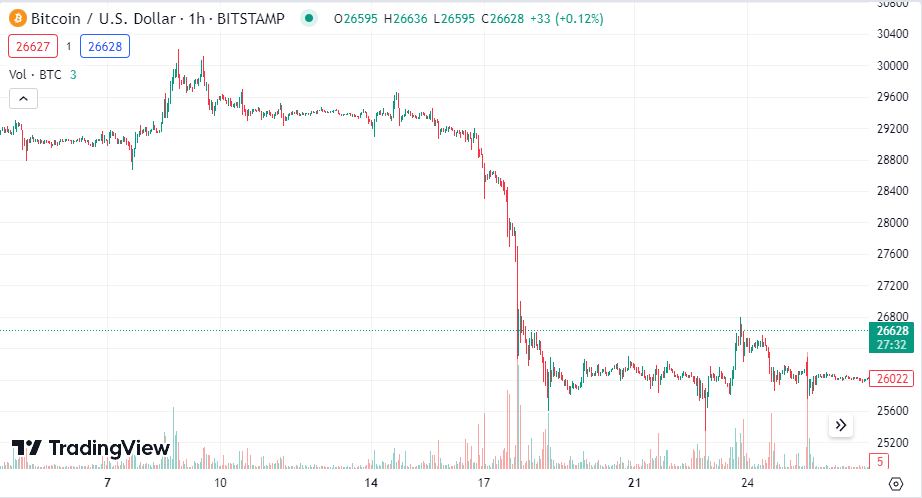What Are Liquidation Cascades in Crypto

This blog post will cover:
- What is a liquidation cascade?
- Why do liquidation cascades occur?
- Liquidation cascade of August 2023
- How to protect your assets against liquidation cascades?
In August 2023, the crypto market experienced some significant price fluctuations, and many coins decreased in price, including Bitcoin and Ethereum. Some experts even went as far as to say that the crypto market went in shock all because of the liquidation cascades.
This article is dedicated to what this phenomenon is, what causes it, and the ways in which investors can make sure their assets are safe.
What is a liquidation cascade?
Similarly to traditional markets, liquidation cascades in crypto happen when lots of traders' positions are forcefully closed by exchanges or trading platforms. This occurs because these traders have borrowed assets to make bigger bets on the coin’s price.
Imagine someone borrows $100 to buy Bitcoin, and they are only required to put down $10 of their own money (10x leverage). If the price of Bitcoin starts to go down, and the borrowed money gets close to running out, the exchange might automatically sell Bitcoin to pay back the borrowed $100. This is a liquidation.
The problem occurs when a large amount of positions gets liquidated all at once (often because the crypto asset’s value is declining), it can cause a chain reaction. As these positions are liquidated, they put more selling pressure on the market, causing the price to drop even further. This can trigger more liquidations, and the cycle continues. It is like a domino effect of selling.
Why do liquidation cascades occur?
Liquidation cascades in crypto markets can be triggered by several factors:
- Volatility. High volatility in cryptocurrency prices might cause rapid price movements. In case the price moves against leveraged positions, it can deplete the collateral held by traders quickly, resulting in liquidations.
- Excessive leverage. Traders who use high levels of leverage (borrowed funds) are more vulnerable to such events. For them, even a small adverse price movement has the potential to cause liquidation.
- Margin calls. If the price of a cryptocurrency goes in the opposite direction of a trader who is using leverage, their exchange or trading platform might issue a margin call. This call demands the trader to add more funds to their account to cushion potential losses. Failure to meet the margin call can result in the forced liquidation of their position.
- Stop-loss orders. Many traders employ stop-loss orders as a means to cap potential losses. When it is activated, it transforms into a market order. In scenarios where there is insufficient liquidity, this can trigger a chain reaction, further driving down the price.
- News. Negative news events or regulatory announcements can lead to sudden and sharp price declines. Traders who are highly leveraged and unprepared for such events may face liquidations.
Liquidation cascade of August 2023
In August 2023, the cryptocurrency market witnessed a series of liquidation events that had a profound impact, particularly on the two largest coins – Bitcoin and Ethereum. These cascading liquidations were part of an ongoing market downturn that can be traced back to November 2022 when BTC hit a notable low point. During this period, many traders had taken on leverage: they borrowed funds to speculate on the potential upward movement of cryptocurrency prices.
As the bearish trend in the market continued, the falling cryptocurrency prices prompted margin calls. Traders were confronted with a crucial decision: either inject more funds to satisfy the margin requirements or confront the possibility of their positions being liquidated. Grayscale's legal victory briefly helped the situation, but the prices eventually went back to their previous lower levels.
This retracement, together with the prevailing negative sentiment in the market, led to one of the most substantial liquidation events in the history of the crypto market, resulting in losses exceeding $1 billion when BTC's price plummeted to $26,000.
In addition to these widespread liquidations, the crypto industry also grappled with a significant decline in venture capital investment throughout August.
During this turbulent period, Bitcoin's price experienced a 7% decline, dropping to approximately $26,900 and briefly touching $25,000, its lowest point since June.
As of September 2023, there has been a moderate recovery in the prices of both cryptocurrencies. On September 18, 1 BTC was valued at $27,206.90, while 1 ETH was trading at $1,653.03.
How to protect your assets against liquidation cascades?
Even though cascade liquidations are large-scale events that can affect all crypto users, there are a few points that are worth keeping in mind:
- Avoid excessive leverage. Use lower levels of leverage or no leverage at all.
- Set stop-loss orders. These orders automatically sell your assets when the price reaches a certain level, preventing further losses. Be sure to place stop-loss orders at levels that consider market volatility and your risk tolerance.
- Stay informed. Sudden news developments or regulatory changes can lead to rapid price swings, so keep up with the news to make timely decisions.
- Keep enough funds. Maintain a sufficient balance in your trading account to cover potential margin calls and fees. If your account balance becomes too low, you may be at higher risk of liquidation.
The phenomenon of liquidation cascades though not exclusive to the Crypto World, has a huge impact on this market in particular because of its high volatility, widespread use of leverage, and some other reasons. While it is quite hard to avoid all the complications that come with it, good investment and risk management strategies should be enough to help you protect your crypto assets.
SimpleSwap reminds you that this article is provided for informational purposes only and does not provide investment advice. All purchases and cryptocurrency investments are your own responsibility.


